The Great Western hunt - 2
As usual I got up in the dark and fixed myself oatmeal and coffee and got my backpack with all the shooting gear and Tiger Stripes and hiked up the hill. It was overcast and misty and the snow line was about 500 feet above the field. A quick scan of everything showed there was no herd of elk on the hillside. I switched over to slow traverse scan with the Kowa and a 32 X eyepiece and still nothing. I poured a cup of coffee out of the thermos and got my worthless binoculars with which I have never ever seen any animal that I could not already see and walked about 30 yards to get a slightly different angle and was looking for deer when suddenly the head and massive rack of an elk materialized out of nowhere.
[floatright]
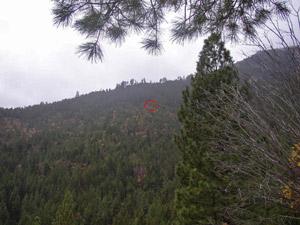 [/floatright]He was near the top of one of the scrub brush fields and only ten yards laterally from the dark timber. I hurried to the Kowa and swung it around and it was clear that he was at least a 5X5 or better and he was alone. The Bushnell 1500 showed the tree line behind him at 968 yards. I checked my firing range chart (old infantry technique from Vietnam) of the hillside and 968 yards was about correct for the top right edge of that clearing. Never knowing when your batteries will quit (of course it was Jimm's battery in my rangefinder) or when a situation will occur that the laser rangefinder would not work such as mist and fog that was present, I had prepared a detailed map of the whole hillside and ranges to every prominent feature. I took my glasses off and read my drop chart and spun up the dial. Then because I did not feel right, I reached up and gave it one more click for luck. The angle was very steep for prone shooting but not in need of a cosine angle adjustment and the short Harris bipods would not extend enough to provide the correct elevation so I moved to the two boulders that I previously lugged over for just such a steep angle shot.
[/floatright]He was near the top of one of the scrub brush fields and only ten yards laterally from the dark timber. I hurried to the Kowa and swung it around and it was clear that he was at least a 5X5 or better and he was alone. The Bushnell 1500 showed the tree line behind him at 968 yards. I checked my firing range chart (old infantry technique from Vietnam) of the hillside and 968 yards was about correct for the top right edge of that clearing. Never knowing when your batteries will quit (of course it was Jimm's battery in my rangefinder) or when a situation will occur that the laser rangefinder would not work such as mist and fog that was present, I had prepared a detailed map of the whole hillside and ranges to every prominent feature. I took my glasses off and read my drop chart and spun up the dial. Then because I did not feel right, I reached up and gave it one more click for luck. The angle was very steep for prone shooting but not in need of a cosine angle adjustment and the short Harris bipods would not extend enough to provide the correct elevation so I moved to the two boulders that I previously lugged over for just such a steep angle shot.
I flopped Tiger Stripes' bipod onto the rocks, leveled her up, tightened the pod-loc and slid the two homemade beanie bags under the butt and it lined up perfectly. Not particularly being fond of the ultra high power settings of the NightForce, I just twisted enough magnification into where I was very comfortable with the crosshair placement on the bull. Afterwards I checked and that it was at about 20 X. Once the gun was steady and the crosshairs were ready to go, I laid my cartridges out and eased one into the action and closed the bolt and waited for the animal to turn broadside for the shot. The elk was very intent on eating and was spending about 30 seconds between steps and was going pretty much straight away.
About that time I realized I had not put anything between the rocks and the bipod legs to absorb shock and that the gun might bounce and cause the shot to go high like my old Ruger #1 always does. I started to get up and go to the back pack but remembered the last time I had taken my eyes off of a buck deer in the same area and never seen him again. So I just lay there hoping the gun was not too sensitive to what was under the bipod. After about ten minutes of peering through the scope at that steep angle my shoulder muscles started getting tired and quivering. I knew that would not go well for the shot and suddenly realized that I had paid extra for an adjustable cheek piece on the A-5 and I had better use it or lose this elk. With the cheek piece raised up, I could relax my neck and then it became a waiting game.
By this time I had counted the tines and knew that this was a true six by six and I had the shot I had dreamed of for 25 years. Briefly, I thought of the wind and felt none and saw none, so dismissed it. After about five more minutes, the elk turned toward the timber which gave me a quartering shot but he suddenly switched back to get a particularly good bite of something to eat and that gave me a true broadside so I lined up exactly back of the shoulder and mid way up the chest. The crosshairs were just really dead steady so I put pressure on the Jewel and it broke and the 200 grain wildcat was away. When all of the exhaust gases cleared away Tiger Stripes was still lined up on target – Shawn builds a good brake.
The bull ran about 10 yards and stopped and began swing its head around looking for danger. It clearly knew something bad had happened but did not know what. I had not seen any impact but the bull was getting ready to run so I slide another 7AM wildcat into the Nesika and closed the bolt. A remembrance from the Long Range Hunting Forum flashed through my mind of Shawn Carlock saying that it was not a good idea to have to track a bull in the steep Idaho mountains and therefore the shoulder shot was preferred. For the first time in my life I lined up on the ball joint of the shoulder and fired. Time of travel is about one second but it seemed like forever before the bull reacted and tried to make a run off the hill. He took two steps and seemed to stumble on the shoulder I had tried to break as he went out of sight behind some small pines. After 25 years, all of my hope and dreams were riding on those two bullets.
[floatright]
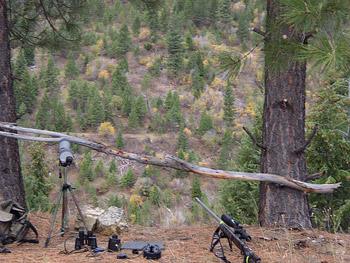 [/floatright]I had a good vantage point of the whole drainage and there was only one alley the bull could use that I might not see him and get a shot if he was on the run. I decided that even though I had broke the trigger cleanly both times that maybe my dialing was still not correct so I would wait for one hour to see if he was alive and trying to move out of the basin. It was 9:01 in the morning and exactly the time I had decided the night before that I would quit hunting and go to town.
[/floatright]I had a good vantage point of the whole drainage and there was only one alley the bull could use that I might not see him and get a shot if he was on the run. I decided that even though I had broke the trigger cleanly both times that maybe my dialing was still not correct so I would wait for one hour to see if he was alive and trying to move out of the basin. It was 9:01 in the morning and exactly the time I had decided the night before that I would quit hunting and go to town.
After an hour I began the ascent, wearing my Peltor 7 earmuffs so if he broke cover I could hear him and still shoot (hunting with a brake is a peculiar thing plus I am pretty deaf). I had Tiger Stripes rigged in the old M-60 hip carry with a sling length that allowed for a lockin' on the shoulder for a running shot and the scope tuned down to 8X. I checked the bulldozer trail as I went up for any sign of him crossing and the higher I got the slower I went. Finally I was 50 yards or so downhill of where he had been when I fired and still I had seen no tracks crossing the trail. Being a bowhunter I am fairly decent at tracking.
I began the climb uphill through the brush and found him lying dead. When I had seen him stumble it was a fall that would cause him to slide 20 yards downhill and probably he was dead before he stopped sliding. The gun Kirby Allen had built had placed both bullets within three inches of each other at a range of 968 yards. The first 200 grain Wildcat had slide in behind the shoulder exactly as I had aimed and expanded and hit at least both lungs if not also heart and exited breaking a rib and making a 1.5 inch hole. The second bullet had exactly centered the ball joint and blown the joint into the chest cavity. The ball joint bone shrapnel sliced up everything inside the chest including most of the heart arteries. The bullet itself did not exit nor did I find any real piece of it.
At one time in my life I would have been dismayed by a bullet that did not exit but the explosion of the ball joint into the chest cavity was extremely effective. It was difficult to tell but it appeared that both bullets had hid the arteries at the top of the heart and almost completely separated them. The first bullet would have been fatal within seconds but I simply had not seen the impact to know how well placed it was. As Jimm can testify, my bullet reloading techniques are something from the medieval dark ages. The ability to place two bullets within an inch or so of the aiming point says something about the craftsmanship of Kirby in building the gun and Richard in building the bullet.
[floatleft]
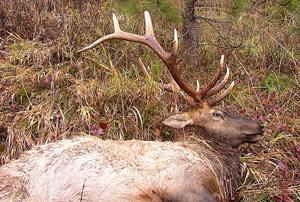 [/floatleft]The bull was a true 6X6 with two broken tines from fighting and several gouges in the head from fighting. The check station measured the length at 41.5 inches. The rack is pretty massive and really wide. I like the broken tines because it shows he was a warrior with good character. My measurements place him at about 298, without the broken tines he would have been over 300. After 25 years of waiting planning and hoping and 54 days of hunting, me and Tiger Stripes had achieved the dream.
[/floatleft]The bull was a true 6X6 with two broken tines from fighting and several gouges in the head from fighting. The check station measured the length at 41.5 inches. The rack is pretty massive and really wide. I like the broken tines because it shows he was a warrior with good character. My measurements place him at about 298, without the broken tines he would have been over 300. After 25 years of waiting planning and hoping and 54 days of hunting, me and Tiger Stripes had achieved the dream.
HE'S DEAD! Now what do I do?
A big elk is Big! If you are alone, a big elk is GIGANTIC! When you shoot him four miles from the truck you wonder if you are crazy. After a while you remember that yes, you are crazy. However, if you have planned on killing an elk you at least have a plan. It might not be a good plan but it and Tylenol are all you have. The first thing I did was gut the elk out and then move him down hill about 50 yards to the bulldozer trail. This was very nearly fatal to me as the elk nearly gored me when I tripped with him sliding at high speed. Just barely did I mange to roll out of the way. I went back to camp and got my external frame backpack and carried all of my skinning and butcher knives and hatchet up to the elk. I skinned him out on one side and then began to work on boning him out. I laid a 9X12 1.5 mil sheet of plastic out on the ground and placed the boned out meat on it to cool and stay clean. Late in the afternoon, I tied the head and rack onto the pack frame and headed for camp (this by the way is illegal in Idaho- the rack comes out last). The next day I took a two wheel game cart up the trail and the external pack and plastic freezer bags. During the night it had snowed on the elk and the meat was really very close to frozen. I put the meat into the freezer bags and those into the backpack which I lashed to the game cart and down the mountain I went. A second trip was made and that got all of the meat to camp (without a single bone in it). Idaho has very stringent wasting laws so I had to take every scrap of meat. I had bought two 100 quart Coleman Extreme coolers which guarantee ice for five days in 90 degree temperatures. That is what I put the elk in.
[floatright]
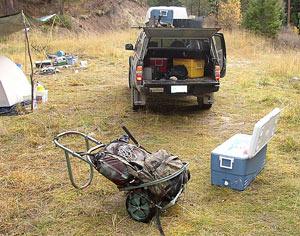 [/floatright]Here is a picture of the cart and frame and cooler. As a note, you should load the cooler into the truck before you fill it up. It is lighter to lift that way. My original plan had been to rent a cold storage locker in Idaho, but apparently there is no such thing anymore. Everyone has a home freezer. Consequently, the only way I had been able to take care of my two antelope was to take them to a butcher and have them made into salami and he kept it in his freezer. I took the two coolers of elk to him on Saturday morning and for free he let it sit in his freezer until Monday morning. On Monday I picked it up and threw a couple of pounds of dry ice in each one and headed for Washington, DC. I stopped by to meet Roy In Idaho and thank him for the good advice on where to hunt. Three days later just after midnight I got home. It took most of one day for me to get the larger pieces of elk thawed out enough to finish cutting it up.
[/floatright]Here is a picture of the cart and frame and cooler. As a note, you should load the cooler into the truck before you fill it up. It is lighter to lift that way. My original plan had been to rent a cold storage locker in Idaho, but apparently there is no such thing anymore. Everyone has a home freezer. Consequently, the only way I had been able to take care of my two antelope was to take them to a butcher and have them made into salami and he kept it in his freezer. I took the two coolers of elk to him on Saturday morning and for free he let it sit in his freezer until Monday morning. On Monday I picked it up and threw a couple of pounds of dry ice in each one and headed for Washington, DC. I stopped by to meet Roy In Idaho and thank him for the good advice on where to hunt. Three days later just after midnight I got home. It took most of one day for me to get the larger pieces of elk thawed out enough to finish cutting it up.
There was just no good place to put the antlers for the trip home so they had to ride up on top of the truck. What a pity!
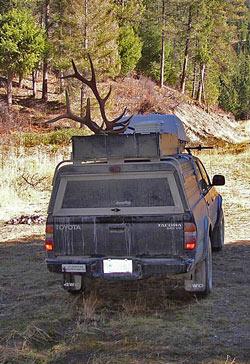
***********************
Jim Collier (Buffalobob) is a retired gov't engineer/physicist who supervised regulatory environmental and fisheries management programs. During the Vietnam War he was a Special Forces officer who ran a recon/sniper platoon and that formed his appreciation for long range hunting.
[floatright]

I flopped Tiger Stripes' bipod onto the rocks, leveled her up, tightened the pod-loc and slid the two homemade beanie bags under the butt and it lined up perfectly. Not particularly being fond of the ultra high power settings of the NightForce, I just twisted enough magnification into where I was very comfortable with the crosshair placement on the bull. Afterwards I checked and that it was at about 20 X. Once the gun was steady and the crosshairs were ready to go, I laid my cartridges out and eased one into the action and closed the bolt and waited for the animal to turn broadside for the shot. The elk was very intent on eating and was spending about 30 seconds between steps and was going pretty much straight away.
About that time I realized I had not put anything between the rocks and the bipod legs to absorb shock and that the gun might bounce and cause the shot to go high like my old Ruger #1 always does. I started to get up and go to the back pack but remembered the last time I had taken my eyes off of a buck deer in the same area and never seen him again. So I just lay there hoping the gun was not too sensitive to what was under the bipod. After about ten minutes of peering through the scope at that steep angle my shoulder muscles started getting tired and quivering. I knew that would not go well for the shot and suddenly realized that I had paid extra for an adjustable cheek piece on the A-5 and I had better use it or lose this elk. With the cheek piece raised up, I could relax my neck and then it became a waiting game.
By this time I had counted the tines and knew that this was a true six by six and I had the shot I had dreamed of for 25 years. Briefly, I thought of the wind and felt none and saw none, so dismissed it. After about five more minutes, the elk turned toward the timber which gave me a quartering shot but he suddenly switched back to get a particularly good bite of something to eat and that gave me a true broadside so I lined up exactly back of the shoulder and mid way up the chest. The crosshairs were just really dead steady so I put pressure on the Jewel and it broke and the 200 grain wildcat was away. When all of the exhaust gases cleared away Tiger Stripes was still lined up on target – Shawn builds a good brake.
The bull ran about 10 yards and stopped and began swing its head around looking for danger. It clearly knew something bad had happened but did not know what. I had not seen any impact but the bull was getting ready to run so I slide another 7AM wildcat into the Nesika and closed the bolt. A remembrance from the Long Range Hunting Forum flashed through my mind of Shawn Carlock saying that it was not a good idea to have to track a bull in the steep Idaho mountains and therefore the shoulder shot was preferred. For the first time in my life I lined up on the ball joint of the shoulder and fired. Time of travel is about one second but it seemed like forever before the bull reacted and tried to make a run off the hill. He took two steps and seemed to stumble on the shoulder I had tried to break as he went out of sight behind some small pines. After 25 years, all of my hope and dreams were riding on those two bullets.
[floatright]

After an hour I began the ascent, wearing my Peltor 7 earmuffs so if he broke cover I could hear him and still shoot (hunting with a brake is a peculiar thing plus I am pretty deaf). I had Tiger Stripes rigged in the old M-60 hip carry with a sling length that allowed for a lockin' on the shoulder for a running shot and the scope tuned down to 8X. I checked the bulldozer trail as I went up for any sign of him crossing and the higher I got the slower I went. Finally I was 50 yards or so downhill of where he had been when I fired and still I had seen no tracks crossing the trail. Being a bowhunter I am fairly decent at tracking.
I began the climb uphill through the brush and found him lying dead. When I had seen him stumble it was a fall that would cause him to slide 20 yards downhill and probably he was dead before he stopped sliding. The gun Kirby Allen had built had placed both bullets within three inches of each other at a range of 968 yards. The first 200 grain Wildcat had slide in behind the shoulder exactly as I had aimed and expanded and hit at least both lungs if not also heart and exited breaking a rib and making a 1.5 inch hole. The second bullet had exactly centered the ball joint and blown the joint into the chest cavity. The ball joint bone shrapnel sliced up everything inside the chest including most of the heart arteries. The bullet itself did not exit nor did I find any real piece of it.
At one time in my life I would have been dismayed by a bullet that did not exit but the explosion of the ball joint into the chest cavity was extremely effective. It was difficult to tell but it appeared that both bullets had hid the arteries at the top of the heart and almost completely separated them. The first bullet would have been fatal within seconds but I simply had not seen the impact to know how well placed it was. As Jimm can testify, my bullet reloading techniques are something from the medieval dark ages. The ability to place two bullets within an inch or so of the aiming point says something about the craftsmanship of Kirby in building the gun and Richard in building the bullet.
[floatleft]

HE'S DEAD! Now what do I do?
A big elk is Big! If you are alone, a big elk is GIGANTIC! When you shoot him four miles from the truck you wonder if you are crazy. After a while you remember that yes, you are crazy. However, if you have planned on killing an elk you at least have a plan. It might not be a good plan but it and Tylenol are all you have. The first thing I did was gut the elk out and then move him down hill about 50 yards to the bulldozer trail. This was very nearly fatal to me as the elk nearly gored me when I tripped with him sliding at high speed. Just barely did I mange to roll out of the way. I went back to camp and got my external frame backpack and carried all of my skinning and butcher knives and hatchet up to the elk. I skinned him out on one side and then began to work on boning him out. I laid a 9X12 1.5 mil sheet of plastic out on the ground and placed the boned out meat on it to cool and stay clean. Late in the afternoon, I tied the head and rack onto the pack frame and headed for camp (this by the way is illegal in Idaho- the rack comes out last). The next day I took a two wheel game cart up the trail and the external pack and plastic freezer bags. During the night it had snowed on the elk and the meat was really very close to frozen. I put the meat into the freezer bags and those into the backpack which I lashed to the game cart and down the mountain I went. A second trip was made and that got all of the meat to camp (without a single bone in it). Idaho has very stringent wasting laws so I had to take every scrap of meat. I had bought two 100 quart Coleman Extreme coolers which guarantee ice for five days in 90 degree temperatures. That is what I put the elk in.
[floatright]

There was just no good place to put the antlers for the trip home so they had to ride up on top of the truck. What a pity!

***********************
Jim Collier (Buffalobob) is a retired gov't engineer/physicist who supervised regulatory environmental and fisheries management programs. During the Vietnam War he was a Special Forces officer who ran a recon/sniper platoon and that formed his appreciation for long range hunting.
